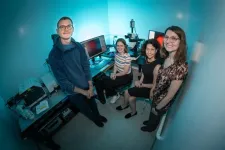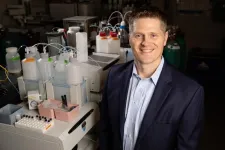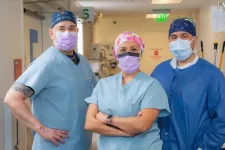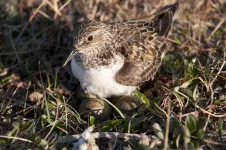(Press-News.org) Viruses, like movie villains, operate in one of two ways: chill or kill.
They can lay low, quietly infiltrating the body’s defenses, or go on the attack, exploding out of hiding and firing in all directions. Viral attacks are almost always suicide missions, ripping apart the cell that the virus has been depending on. The attack can only succeed if enough other healthy cells are around to infect. If the barrage of viral particles hits nothing, the virus cannot sustain itself. It doesn’t die, since viruses aren’t technically alive, but it ceases to function.
So for a virus, the key challenge is deciding when to flip from chill mode into kill mode.
Four years ago, Princeton biologist Bonnie Bassler and her then-graduate student Justin Silpe discovered that one virus has a key advantage: it can eavesdrop on the communication between bacteria. Specifically, it listens for the “We have a quorum!” chemical that bacterial cells release when they have reached a critical number for their own purposes. (The original discovery of this bacterial communication process, called quorum sensing, has led to a string of awards for Bassler and her colleagues.)
Now Bassler, Silpe and their research colleagues have found that dozens of viruses respond to quorum sensing or other chemical signals from bacteria. Their work appears in the current issue of Nature.
“The world is loaded with viruses that can surveil appropriate host information,” said Bassler, Princeton’s Squibb Professor in Molecular Biology and the chair of the department of molecular biology. “We don’t know what all the stimuli are, but we showed in this paper that this is a common mechanism.”
Not only did they demonstrate the strategy’s abundance, but they also discovered tools that control it and send signals that tell the viruses to flip from chill into kill mode.
The kind of viruses that attack bacterial cells, known as bacteriophages — or phages for short — land on the surface of a bacterial cell and deliver their genes into the cell. More than one kind of phage can infect a bacterium at the same time, as long as they’re all in chill mode, which biologists call lysogeny. When it involves multiple phages chilling in a single bacterium, it’s called polylysogeny.
In polylysogeny, the phages can coexist, letting the cell copy itself over and over again as healthy cells do, the viral DNA or RNA hidden tucked inside the bacterium’s own, replicating right along with the cells.
But the infiltrating phages aren’t exactly peaceful; it’s more like mutually assured destruction. And the tenuous detente lasts only until something triggers one or more of the phages to switch into kill mode.
Scientists studying phage warfare have long known that a major disruption to the system — like high-dose UV radiation, carcinogenic chemicals, or even some chemotherapy drugs — can kick all the resident phages into kill mode.
At that point, scientists thought, the phages start sprinting for the bacterium’s resources, and whichever phage is the fastest will win, shooting out its own viral particles.
But that’s not what Bassler’s team found.
Grace Johnson, a postdoctoral research associate in Bassler’s research group, used high-resolution imaging to watch individual bacterial cells that were infected with two phages as she flooded them with one of these universal kill signals.
Both phages leapt into action, shredding the host cell. To see the outcome, Johnson “painted” each phage’s genes with special fluorescent tags that light up in different colors depending which phage was replicating.
When they lit up, she was shocked to see that there wasn’t a clear winner. It wasn’t even a tie between the two. Instead, she saw that some bacteria glowed with one color, others with the second color, and still others were a blend — simultaneously producing both phages at the same time.
“No one ever imagined that there would be three subpopulations,” said Bassler.
“That was a really exciting day,” said Johnson. “I could see the different cells undertaking all the possible phage production combinations — inducing one of the phages, inducing another, inducing both. And some of the cells were not inducing either of the phages.”
Another challenge was to find a way to trigger only one of the two phages at a time.
Silpe, who had come back to Bassler’s lab as a postdoctoral research associate after performing postdoctoral studies at Harvard, had taken the lead on finding the triggers. While the team still doesn’t know what signals these phages respond to in nature, Silpe has designed a specific artificial chemical trigger for each phage. Grace Beggs, another postdoctoral fellow in the Bassler group, was instrumental in the molecular analyses of the artificial systems.
When Silpe exposed the polylysogenic cells to his cue, only the phage that responded to his artificial trigger replicated, and in all of the cells. The other phage remained wholly in chill mode.
“I didn’t think it would work,” he said. “I expected that because my strategy did not mimic the authentic process found in nature, both phages would replicate. It was a surprise that we saw only one phage. No one had ever done that before, that I’m aware of.”
“I don’t think anybody even thought to ask a question about how phage-phage warfare plays out in a single cell because they didn’t think they could, until Grace J. and Justin did their experiment,” Bassler said. “Bacteria are really tiny. It’s hard to image even individual bacteria, and it’s really, really hard to image phage genes inside bacteria. We’re talking smaller than small.”
Johnson had been adapting the imaging platform — fluorescence in situ hybridization, usually called FISH — for another quorum-sensing project involving biofilms, but when she heard Silpe share his research at a group meeting, she realized that FISH could reveal what up to that point were intractable secrets about his eavesdropping phages.
The majority of the world’s bacteria have more than one phage chilling inside of them, “but nobody’s been able to manipulate and image them the way these two did,” Bassler said. “The cunning strategy where they could induce one phage, the other phage, or both phages on demand — that was Justin’s coup, and then to be able to actually see it happening in a single cell? That’s also never been done. That was Grace J. We can see the phage warfare at the level of the single cell.”
Nearly all genes on viral genomes remain mysterious, Bassler added. We simply don’t know what most viral genes do.
“Yes, here, we discovered the functions of a few phage genes, and we showed that their jobs are to enable this completely unexpected chill-kill switch and that the switch dictates which phage wins during phage-phage warfare. That discovery suggests there remain potentially even more exciting processes left to find,” she said. “Phages started the molecular biology era 70 years ago, and they’re coming back into vogue both as therapies and also as this incredible repository of molecular tricks that have been deployed through evolutionary time. It’s a treasure trove, and it’s almost completely unexplored.”
“Small protein modules dictate prophage fates during polylysogeny,” by Justin E. Silpe, Olivia P. Duddy, Grace E. Johnson, Grace A. Beggs, Fatima A. Hussain, Kevin J. Forsberg and Bonnie L. Bassler, was published in Nature on July 26 (DOI:10.1038/s41586-023-06376-y). The research was supported by Princeton University's endowment, the Howard Hughes Medical Institute (HHMI), the National Institutes of Health (NIH), the National Science Foundation (NSF), the Jane Coffin Childs Memorial Fund for Medical Research (JCC Fund), the NIH Office of Extramural Research (OER) and the Damon Runyon Cancer Research Foundation.
END
How eavesdropping viruses battle it out to infect us
Bonnie Bassler and her team have found that dozens of viruses respond to quorum sensing or other chemical signals from bacteria. Their work appears in the current issue of Nature
2023-07-26
ELSE PRESS RELEASES FROM THIS DATE:
Unraveling a protein that may inspire a new biotechnology tool
2023-07-26
COLUMBUS, Ohio – Scientists have unraveled the step-by-step activation process of a protein with a deep evolutionary history in all domains of life, opening the door to harnessing its functions for use as a biotechnology tool.
The protein belongs to the “superfamily” of Argonaute proteins, which previous research has suggested to be involved in gene silencing, a fundamental process known as RNA interference.
These proteins are well-characterized in eukaryotes – the plants, fungi, animals, humans and other life forms with cells that have a defined ...
Study: Insect protein slows weight gain, boosts health status in obese mice
2023-07-26
URBANA, Ill. — As the global population grows under a changing climate, the urgency to find sustainable protein sources is greater than ever. Plant-based “meat” and “dairy” products may be popular, but they’re not the only environmentally friendly meat alternatives.
A new study in mice from the University of Illinois Urbana-Champaign suggests replacing traditional protein sources with mealworms in high-fat diets could slow weight gain, improve immune response, reduce inflammation, enhance energy metabolism, and ...
Recent advances in research to identify sources of nano- and microplastics
2023-07-26
Exposure to microplastics and nanoplastics — particles smaller than 5 millimeters and 1 micrometer across, respectively — have been linked to adverse health outcomes. Although some of their sources are well known, others haven’t been thoroughly vetted yet. Below are recent papers published in ACS journals that report new insights into the origins of some microscopic plastic pieces: laser-cut acrylic sheets, orthodontic rubber bands and children’s food containers. Reporters can request free access to these papers by emailing newsroom@acs.org.
“Characterization ...
Mount Sinai researchers uncover how mammary glands control overall energy balance and fat metabolism
2023-07-26
An Icahn School of Medicine at Mount Sinai study sheds light on the intricate interplay between mammary adipose (fat) tissue and breast health, and offers exciting possibilities for understanding breast development, lactation, cancer, and obesity and related metabolic disorders.
The study was published today in Nature. The research team was led by Prashant Rajbhandari, PhD, Assistant Professor of Medicine (Endocrinology, Diabetes and Bone Disease), and a member of the Diabetes, Obesity, and Metabolism Institute at Icahn Mount Sinai.
The ...
Study in journal Nature Communications finds high blood glucose levels sensitizes pancreatic cancer cells to chemotherapy
2023-07-26
CLEVELAND - Pancreatic cancer is one of the most difficult cancers to treat, being highly resistant to chemotherapy.
However, there are no effective alternative therapies to chemotherapy, so chemo remains the best available treatment.
Although there are fewer than roughly 60,000 new cases of pancreatic cancer diagnosed annually in the U.S., about 95 percent of people with it die from it, mainly because it often goes undetected in early stages.
Approved multi-agent chemotherapy regimens offer a marginal advance over single-agent ...
Global wildlife trade risks altering evolutionary history and ecosystem function, study suggests
2023-07-26
Some of the world’s most distinct and ancient animal species, which play crucial roles in our planet’s ecosystems, are exploited for the wildlife trade across large parts of the world, according to new research from the University of Sheffield.
The study, led by researchers from the University’s School of Biosciences, has found that in large areas of the world, a wide range of functionally and evolutionarily distinct species are targeted for the wildlife trade, which has the potential to cause major losses of evolutionary history and alter key ecological processes.
Published in Nature, the ...
For people with diabetes, healthy eating is not enough if their diet is rich in ultra-processed foods
2023-07-26
The very first rule for people diagnosed with type 2 diabetes is to eat a healthy nutritious diet. Attention to ingested calories, as well as nutrients contained in various foods, become integral parts of a diabetic person's life. However, this might not be enough: an important role in determining the future health status of people with this condition could be played by the degree of processing of foods that end up on the dish. These products are described as "ultra-processed" and are associated with adverse health outcomes, as reported in general population studies.
A study conducted by the Department of Epidemiology and Prevention at the I.R.C.C.S. Neuromed in Pozzilli, ...
Keck Hospital of USC receives highest rating on national quality report
2023-07-26
LOS ANGELES, CA — Keck Hospital of USC earned five stars, the highest rating possible, on the Centers for Medicare & Medicaid Services (CMS) 2023 quality star rating report.
Only approximately 16% of hospitals across the country, 483 out of 3,076, received five stars out of a one-to-five-star rating system.
“This prestigious designation demonstrates our continuing commitment to patient safety and to best patient outcomes, and is the result of the hard work of every physician, nurse and staff member at the hospital,” said Stephanie Hall, MD, MHA, chief medical officer ...
Earlier and earlier high-Arctic spring replaced by “extreme year-to-year variation”
2023-07-26
About 15 years ago, researchers reported that the timing of spring in high-Arctic Greenland had advanced at some of the fastest rates of change ever seen anywhere in the world. But, according to new evidence reported in the journal Current Biology on July 26, that earlier pattern has since been completely erased. Instead of coming earlier and earlier, it seems the timing of Arctic spring is now driven by tremendous climate variability with drastic differences from one year to the next.
“As scientists we are obliged to revisit previous ...
Mapping mass shootings in the United States
2023-07-26
The United States has more than 10 times the number of mass shooting incidents than other developed countries, yet little research has shown the distribution and types of shootings, geographically.
“I’m constantly asked, ‘What is public health doing about the rise in mass shootings?” says Leslie Barnard, MPH, a student working with the University of Colorado School of Medicine’s Firearm Injury Prevention Initiative.
Barnard, a doctoral candidate in the Department of Epidemiology in the Colorado School of Public Health at the CU Anschutz Medical Campus, wanted to find answers to address public ...
LAST 30 PRESS RELEASES:
Studies investigate how AI can aid clinicians in analyzing medical images
Researchers pitch strategies to identify potential fraudulent participants in online qualitative research
Sweeping study shows similar genetic factors underlie multiple psychiatric disorders
How extreme weather events affect agricultural trade between US states
Smallholder farms maintain strong pollinator diversity – even when far from forests
Price of a bot army revealed across hundreds of online platforms worldwide – from TikTok to Amazon
Warblers borrow color-related genes from evolutionary neighbors, study finds
Heat signaling from plants is an ancient pollinator signal
New index reveals the economics underlying the online manipulation economy
High-resolution satellite observations reveal facility-level methane emissions worldwide
Researchers discover how Ebola and Marburg disrupt the gastrointestinal tract
Feeling the heat
Eastward earthquake rupture progression along the Main Marmara Fault towards Istanbul
Scientists uncover how Earth’s mantle locked away vast water in early magma ocean
Scientists uncover key driver of treatment-resistant cancer
Rare image of Tatooine-like planet is closest to its twin stars yet
Music: Popular song lyrics have become more negative since 1973
Marine ecology: Killer whales tail dolphins to hunt salmon
ADHD prescriptions on the rise, study finds
How to build a genome
Sharp rise in ADHD stimulant prescriptions in Ontario, research finds
Trends and prevalence of the metabolic syndrome among US adults
Population-level trends in ADHD medication prescribing
Missing piece of myelin disturbs the brain’s rhythm
Insilico Medicine and Taigen achieves license agreement to develop and commercialize AI-driven PHD inhibitor for anemia of Chronic Kidney Disease (CKD)
Exploring dominant endophytic Pleosporales in grasses: New taxonomic insights in the suborder Massarineae
Comparative transcriptomic analysis of human maxillary and mandibular tooth germs reveals discrepancies in gene expression patterns
Scientists detect atmosphere on molten rocky exoplanet - study
Chip-scale magnetometer uses light for high-precision magnetic sensing
Illinois Tech biomedical engineering professor Philip R. Troyk elected as Fellow of the National Academy of Inventors
[Press-News.org] How eavesdropping viruses battle it out to infect usBonnie Bassler and her team have found that dozens of viruses respond to quorum sensing or other chemical signals from bacteria. Their work appears in the current issue of Nature



